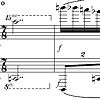
for solo piano; length: 4:33
Story behind the song
MP3 Notes: MidiEngine: Creative Labs X-FI Fatality. Sequencer: Sibelius 4. MidiFont: Kontakt Player Gold (Sibelius Ed.).
About this piece: Written for submission to a composition contest held by Karl H. Wittenberg. The competition closed Dec. 31, 2006. The stipulation was simple: "Any composition with the time signature 7/8." (See Submissions and Results, below.)
Composed 12-13 July (initial notes, ideas, melody & basic harmonic structure), 28-30 November to 8 December 2006.
A Look at My Methodology for This One. I started by assuming that "seven-eight" was applicable to more than just the time signature. I played around with the numbers themselves.
12-13 July 2006: I worked out the bulk of the structural elements for this piece. First: Rhythm. I determined that the internal rhythm of each measure was going to be 2+2+3 (but of course, there are some exceptions for variety; for examples: the opening section has the LH playing 3+2+2; there are also times when the RH will play 2+2+3 while the LH plays 3+2+2). Second: Key (~s). I started at C Major on the circle of fifths and went three key signatures in one direction to the key of Eb Major/c minor; then going four keys in the opposite direction (again from C), I came to E Major/c# minor. Three + four = seven. Silly, but that's where I started. I then decided to compose the RH in Eb Major and the LH in E Major. Third: Melody. Once the decision about keys was reached, I looked for the tones (notes) that the two keys had in common (c, d#/e-flat, g#/a-flat, a, b, b-flat), and decided to make my principal theme out of those notes. The principal theme places the notes in this order: c, e-flat, a, b, b-flat, c-flat, e-flat, b, b-flat, a, e-flat, a-flat, c, a, b-flat, a-flat. The theme is jagged and anxious and has a strong forward-moving feel. Fourth: Instrumentation. This was perhaps the easiest decision at the beginning. I decided on the piano-but wanted to limit the range from the standard eighty-eight keys down to seventy-eight. When I took off the top and bottom five keys, I was left with the lowest c and the highest a-flat on the piano. Ironically, these notes were the first and last notes of the principal theme I had already written. All throughout these first two days, I was thinking in the back of my mind about a name for the piece. I started by calling it simply "78" (for obvious reasons).
28 Nov. 2006: Composition began on this piece. Sections. I decided to open the piece with a statement of the range (that lowest c and the highest a-flat), then roar down in a whirlwind of notes out of which the theme would be heard to emerge. The opening-the "discovery" (emergence) and development of the principal theme is section A. (I frequently place a development section before the statement of the actual theme because I like the idea of the melody seeming to grow out of the playing as if through improvisation.) The rhythm of 7/8 didn't solidify until measure three; the melody makes its first somewhat tentative appearance in measure ten as a single line, then adds intervals with each restatement until it's really quite grand by the fourth incarnation. All this happens in section B. The harmonies in that opening section (section A) begin by utilizing the common notes (for the most part) with an occasional non-shared note thrown in. As the piece progresses, the harmonies strive towards one key or the other. The RH, which plays the melody, wins first and we slow down (in feeling) and land in Eb Major with the secondary theme—a much more consonant creation. Section C states the secondary theme, though the LH remains in its key playing an accompaniment that harps quietly with an undertone of the principal theme. This section ends with the principal theme restated and the secondary theme dovetailed onto the end of it. The secondary theme is entirely what section D is all about. Late in the writing, I worked to mould the piece into seven sections. I already had six, and added sec